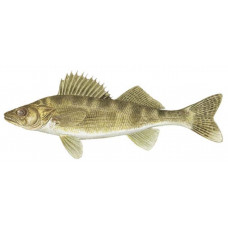Latin name
Stizostedion vitreum
Other names
Pickerel, yellow pickerel, walleyed pike, yellow walleye, jack salmon, jack, pike-perch, walleyed pikeperch, pike, gray pike, green pike, ’eye, marbleye, glass-eye; French: doré.
Identification
Walleye have a slender cylindrical body with a conical head. The first dorsal fin has sharp spiny rays and is separated from the second dorsal fin by soft rays. The cheeks are covered with sparse scales, the gill covers are sharp, and the teeth are sharp. When handling the fish, anglers must be careful around the teeth, gill covers, and spiny dorsal fin to avoid cuts and puncture wounds. Walleye have a dark green back, golden yellow sides, and a white belly. The lower lobe of the caudal fin is white, and there is a large black spot on the posterior base of the first dorsal fin. The coloration is very variable depending on the habitat, in many populations a golden color is characteristic. Fish in turbid or uncolored waters are usually paler, with less pronounced black markings. In clear waters, more distinct specimens are found. Perhaps the most striking feature of the zander is its large, white, glossy eyes. A special reflective layer in the retina is a feature known as the tapetum lucidum. It collects light entering the eye, making it extremely sensitive to bright daylight, but advantageous for night vision.
Distribution
Walleye are widely distributed throughout North America. Its native range in the north extended from Great Bear Lake in the Northwest Territories eastward to James Bay and St. Lawrence Bay. In the east, it extended south along the Allegheny Mountains to Georgia and the coastal Mississippi and Alabama rivers. To the west, it extended from Saskatchewan through the Dakotas to Arkansas. As a result of natural expansion and widespread introduction, the range was extended eastward to the Atlantic coast drainages from Vermont to South Carolina and westward to all western states except California, as well as southern Alberta and British Columbia.
Habitat
Walleye can tolerate a wide variety of environmental conditions, but they do best in the open waters of large lakes and reservoirs, as well as in the basins of large rivers. They live in many smaller bodies of water, but are generally not very prolific in the muddiest environments, preferring cleaner water than their Sauger relatives. They prefer gravel, rocky and hard sandy bottoms and may associate with various weeds. They also use submerged trees, standing timber, rocky banks and reefs for shelter and feeding. They can tolerate temperatures from 32° to 90°F, but prefer waters with a maximum temperature of about 77°, and usually inhabit waters from 65° to 75° in the summer.
Size
Walleye vary in size depending on the habitat, but anglers typically catch fish between 10 and 18 inches long and 1 to 3 pounds. Some waters have fish that average larger, and in many places it is not uncommon to catch fish that weigh more than 5 pounds. The world record for any tackle is a 25-pound walleye caught in Old Hickory Lake, Tennessee in 1960.
Life history and Behavior
Spawning occurs in spring or early summer, depending on latitude and water temperature. Spawning usually begins shortly after the ice melts in frozen lakes. Spawning can occur at temperatures between 38° and 50°F. The males are the first to move to the spawning grounds. These are usually rocky areas in flowing water below impassable waterfalls and dams in rivers and streams, large pebble banks, or (less commonly) along stony lake shores in water less than 6 feet deep. Spawning occurs at night in groups of one large female and one or two small males, or two females and numerous males. Male walleyes are not territorial and do not nest. In clear lakes, zander often lie on the bottom during the day as if resting. In such lakes, they usually feed at night. In murky water, they are more active during the day, swimming slowly in groups near the bottom. Walleye are often found with other species such as yellow perch, northern pike, white suckers, and smallmouth bass. During the winter, walleye do not change habitat except to avoid strong currents. In large waters, they concentrate on open water and gather in schools that coincide with the presence of baitfish, especially alewives, as well as shad and perch.
Food and feeding habits
Walleye can be voracious feeders, consuming primarily other fish. Their broad diet includes alewives, smelt, shad, cisco, shiners, sculpin, suckers, minnows, darters, perch, and crayfish, among many others. As walleye grow, their diet changes rapidly from invertebrates to fish. Some populations, even as adults, feed almost exclusively on emerging larvae or adult mayflies for part of the year. The relative number of different fish species that zander feed on is obviously determined by their availability. Yellow perch and cyprinids are particularly preferred when these species are present.
Reproduction
No information
| Classification | |
| Phylum | Chordata |
| Class | Actinopterygii |
| Squad | Perciformes |
| Family | Percidae |
| Genus | Sander |
| Species | S. vitreus |
| Features | |
| Conservation status | Least Concern |
| Habitat | Pelagic |
| Life span, years | No information |
| Maximum body weight, kg | 13 |
| Maximum length, cm | 107 |
| Sailing speed, m/s | No information |
| Threat to people | Edible |
| Way of eating | Predator |
Walleye
Tags: Walleye

